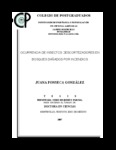Ocurrencia de insectos descortezadores en bosques dañados por incendios
Abstract
Con el propósito de develar la posible interacción entre los incendios forestales y la subsecuente infestación por descortezadores y barrenadores de madera, se propusieron dos estudios diferentes. El primero se enfoca en el daño del incendio sobre árboles individuales. A través de regresión logística fue posible vincular la evidencia física del daño sobre árboles adultos de Pinus montezumae y la proporción de galerías con respecto a otros descortezadores (Pityophthorus, Hylastes e Hylurgops) y barrenadores de madera (Buprestidae y Cerambycidae). La proporción de galerías de Ips disminuye cuando el diámetro y la altura del chamuscado del fuste aumentan, mientras que esta proporción se incrementa con la longitud de copa viva. El análisis muestra que los barrenadores de madera tienen preferencia por los árboles con daño severo pero con yemas vivas. Los árboles pequeños son más sensibles a la infestación de Ips con cualquier nivel de daño en la copa.
El segundo estudio se dedicó a identificar las principales familias y géneros de Coleoptera que arriban a árboles jóvenes de P. montezumae dañados por un incendio, así como a registrar los patrones de acumulación de los diferentes grupos de insectos. Se aplicó un pegamento a los troncos de los árboles y cada dos semanas durante los primeros cinco meses después del incendio se colectaron los insectos que se adhirieron. La abundancia relativa por fecha y por grupo de insectos se ajustó a una curva de regresión logística para determinar si existían diferencias en su patrón de acumulación entre los grupos y entre los descortezadores y sus depredadores. Las principales familias que se identificaron fueron: Curculionidae, Buprestidae, Cleridae, Salpingidae, Elateridae Colydiidae, Bostrichidae y Staphylinidae. Se observaron diferencias entre el patrón de acumulación de descortezadores primarios y barrenadores de madera con respecto al conjunto de descortezadores. El patrón de acumulación de los descortezadores y sus depredadores tiene la misma tendencia. Durante el muestreo se encontró una nueva especie de Lechriops Schönherr._______To unveil the possible interaction between forest fires and the subsequent bark beetle attack and wood borer infestation two different studies were done. The first study is concerned with forest-fire damage on individual trees. Through logistic regression it was possible to link the evidence of physical damage on adult trees of Pinus motezumae to the proportion of Ips vs. other bark beetles (Pityophthorus, Hylastes, Hylurgops) and woodborers (Buprestidae and Cerambycidae families). The proportion of Ips galleries decreased as DBH size and tree bole char height increased, whereas this proportion increased with live crown length. The analysis shows those woodborers are greatly attracted to heavily damaged, but live trees. Small trees are more sensitive to Ips infestation despite damage class.
The second study was devoted to identify the main coleoptera taxa arriving at young trees of P. montezumae damaged by a wildfire. Stick-up traps were used and two-week periodic samples were taken for five months after the wildfire. The relative abundance for date and for group of insects was adjusted to a curve of logistical regression to determine if differences existed in their pattern of accumulation among the groups and between the bark beetles and their predators. The main families that were identified were: Curculionidae, Buprestidae, Cleridae, Salpingidae, Elateridae Colydiidae, Bostrichidae and Staphylinidae. Differences were observed between the pattern of accumulation of primary bark beetles and woodborers with regard to the bark beetles group. The pattern of accumulation of the bark beetles and their predators have the same tendency. A new species of Lechriops Schönherr was also found during the sampling.
Collections
- Tesis MC, MT, MP y DC [284]


